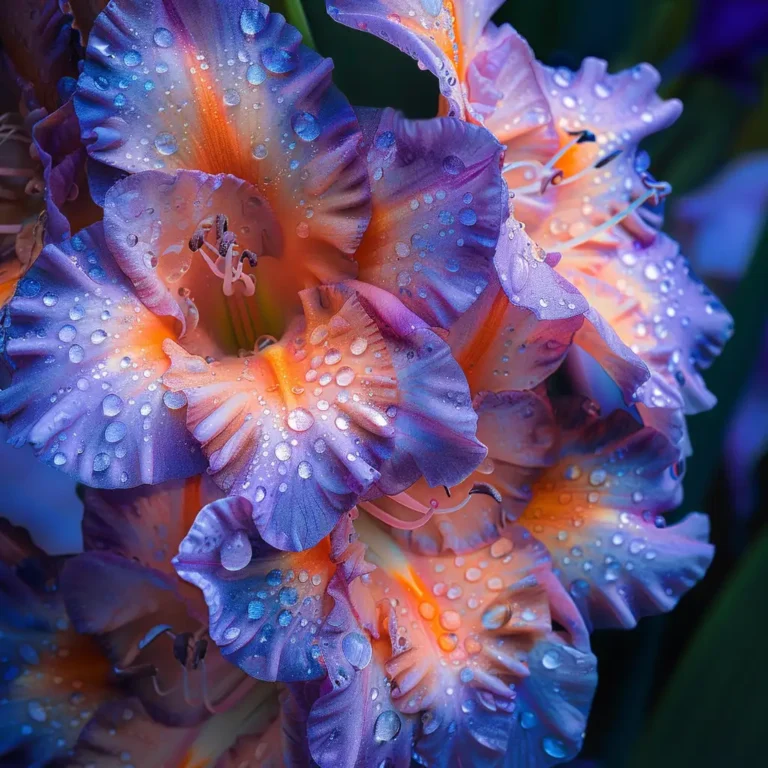Introduction to Gladiolus
Gladiolus, often referred to as the sword lily, is a stunning flowering plant known for its tall spikes of vibrant blooms. These flowers have a rich history, dating back to ancient times when they symbolized strength and moral integrity. Today, gladioli are popular in gardens and floral arrangements due to their striking appearance and variety of colors.
Botanical Description
The gladiolus belongs to the Iridaceae family and comprises about 260 species. These perennials are characterized by their sword-shaped leaves and tall flower spikes. They come in various sizes and colors, making them a versatile choice for gardeners looking to add a splash of color to their landscape.
Planting Gladiolus
Planting gladiolus is relatively straightforward, but timing and soil conditions are crucial for successful growth.
- Best Time to Plant: The ideal time to plant gladiolus bulbs is in the spring, after the danger of frost has passed.
- Soil Requirements: Gladiolus thrives in well-drained, sandy soil with a pH between 6.0 and 6.5.
- How to Plant Gladiolus Bulbs:
- Choose a sunny location.
- Plant the bulbs 4-6 inches deep and 6 inches apart.
- Water the soil thoroughly after planting.
Caring for Gladiolus
Proper care ensures that your gladiolus blooms beautifully and remains healthy.
- Watering Needs: Keep the soil consistently moist but not waterlogged. Water deeply once a week, more often during dry spells.
- Fertilizing: Use a balanced fertilizer (10-10-10) when the shoots first appear and again when the flower spikes develop.
- Mulching: Apply a 2-3 inch layer of mulch around the plants to retain moisture and control weeds.
Pest and Disease Management
Gladiolus is susceptible to several pests and diseases, but with proper management, you can keep your plants healthy.
- Common Pests: Watch out for thrips, aphids, and spider mites.
- Disease Prevention: Ensure good air circulation and avoid overhead watering to prevent fungal diseases.
- Treatment Methods: Use insecticidal soap for pests and fungicides for diseases.
Propagating Gladiolus
Propagating gladiolus can be done through seeds or bulb division.
- Methods of Propagation:
- Seed propagation is less common and more time-consuming.
- Bulb division is the preferred method, involving the separation of cormlets from the parent bulb.
- Seed Propagation: Plant seeds in a well-draining seed-starting mix and keep them moist.
- Bulb Division: Separate the cormlets from the parent bulb in the fall and store them in a cool, dry place until spring.
Designing with Gladiolus in Gardens
Incorporating gladiolus into your garden design can create a stunning visual impact.
- Companion Plants: Pair gladiolus with dahlias, zinnias, and marigolds for a vibrant garden bed.
- Landscape Design Ideas: Use gladiolus as a backdrop for shorter plants or as a focal point in flower beds.
- Seasonal Considerations: Plant gladiolus in succession every two weeks for continuous blooms throughout the summer.
Harvesting Gladiolus
Harvesting gladiolus at the right time ensures long-lasting flowers.
- When to Harvest: Cut the flower spikes when the lower three or four flowers are open.
- How to Cut and Handle Flowers: Use a sharp knife or scissors to cut the spikes early in the morning. Place the cut stems in water immediately.
Storing Gladiolus Bulbs
Proper storage of gladiolus bulbs ensures they are ready for the next planting season.
- Post-Harvest Care: Dig up the bulbs after the first frost. Remove any soil and allow them to dry for a few weeks.
- Storage Conditions: Store the bulbs in a cool, dry place. Keep them in mesh bags or paper sacks to ensure air circulation.
- Preparing for Next Season: Inspect the bulbs for any signs of disease before replanting in the spring.
FAQs
- How long do gladiolus flowers last?
Gladiolus flowers typically last about one to two weeks in a vase. - Can gladiolus be grown in pots?
Yes, gladiolus can be grown in pots as long as the container is deep enough for the bulbs. - How deep do you plant gladiolus bulbs?
Plant gladiolus bulbs 4-6 inches deep. - Are gladiolus flowers annual or perennial?
Gladiolus are perennial flowers but are often grown as annuals in colder climates. - What is the best fertilizer for gladiolus?
A balanced fertilizer with equal parts nitrogen, phosphorus, and potassium (10-10-10) is ideal for gladiolus.
Conclusion
Growing gladiolus can add beauty and elegance to any garden. With proper planting, care, and maintenance, these stunning flowers will reward you with vibrant blooms throughout the summer. Whether you’re a seasoned gardener or a beginner, gladiolus is a wonderful addition to your garden. Happy planting!

